This post may contain affiliate links. Please read my privacy policy.
Rad Na is a beloved Thai-Chinese noodle dish. My easy and authentic Rad Na recipe combines soft, flat rice noodles with crisp vegetables, succulent chicken, and juicy shrimp, all bathed in a flavorful sauce. It’s a must-try dish!
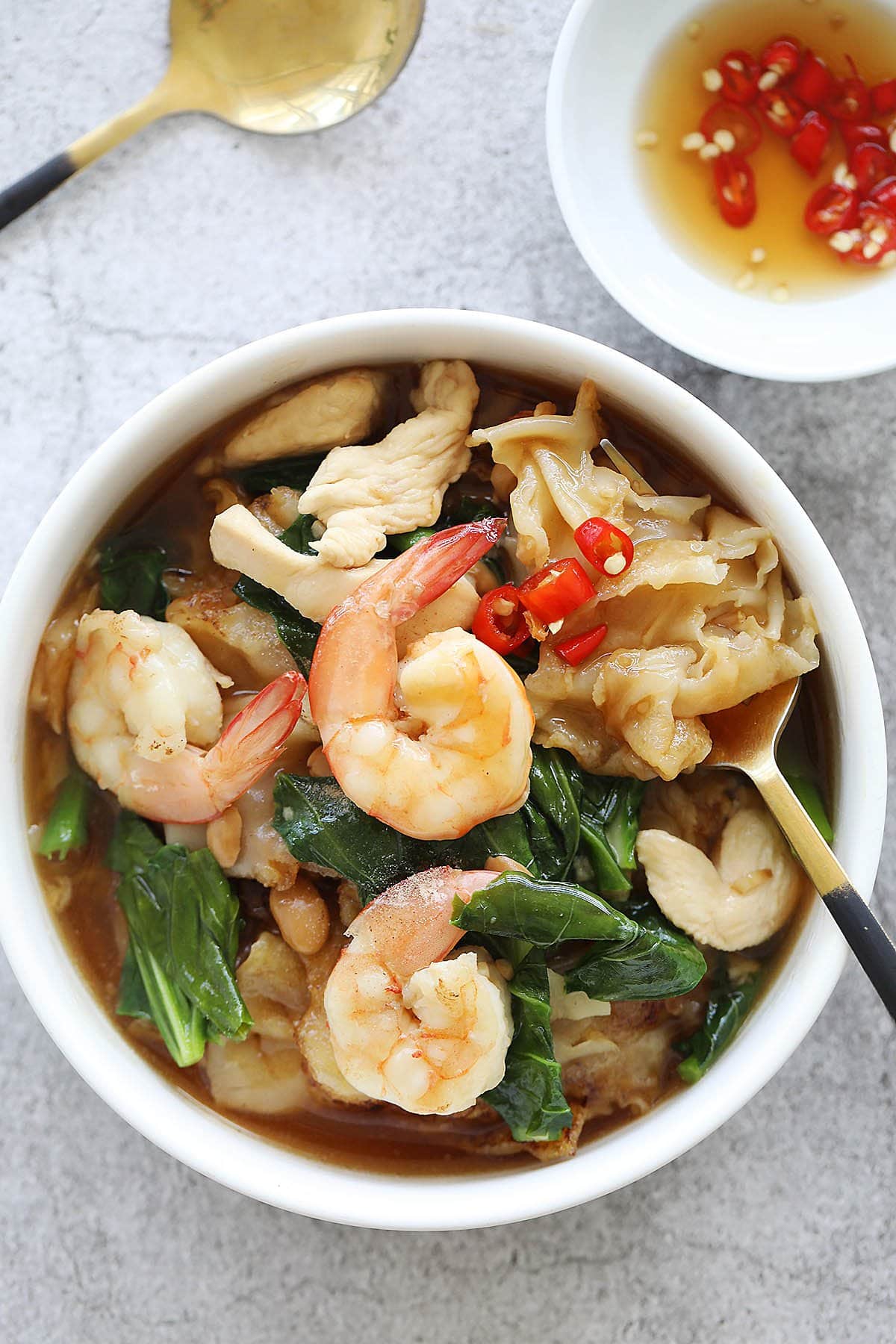
Rad Na Noodles
What is Rad Na?
Rad Na, also known as Rad Na Kuay Tiew, is a Thai-Chinese noodle dish. The name may also be spelled Rad Nah, Rad Nar, Lad Na, or Lard Na due to transliteration variations from Thai to English, but they all refer to stir-fried flat rice noodles in a rich, savory sauce or gravy.
Originating in China, this dish is now popular throughout Asia. In Malaysia, it is known as Char Hor Fun or Wat Tan Hor, while in Laos, it is called Lad Na.
Regardless of its regional variation, it is always delicious and satisfying—soft noodles drenched in a savory sauce with seafood, meat, and vegetables.
There are two versions of this noodle dish: one made with preserved soy beans (taucheo) and one without. I prefer the version with taucheo. The preserved soy beans adds an earthy nuance to the sauce, balancing the somewhat sweet flavor.
Whether you enjoy it with or without taucheo, Rad Na promises a comforting and flavorful experience that highlights the versatility and richness of this beloved noodle dish.
Why You’ll Love Lad Na

You’ll love Rad Nah noodles because of the following reasons:
- It’s yummy: The rich, savory sauce perfectly coats the soft, stir-fried rice noodles, delivering a comforting depth of flavor.
- Versatile ingredients: Tender seafood, meat, and vegetables enhance the dish with a variety of textures and tastes.
- Perfect taste: The combination of flavors, whether with preserved soy beans or in the classic version, provides a satisfying culinary experience.
- Filling meal: Rad Na offers a hearty meal that is both filling and delicious, making it a go-to choice for a comforting dinner.
Ingredients For Rad Nar
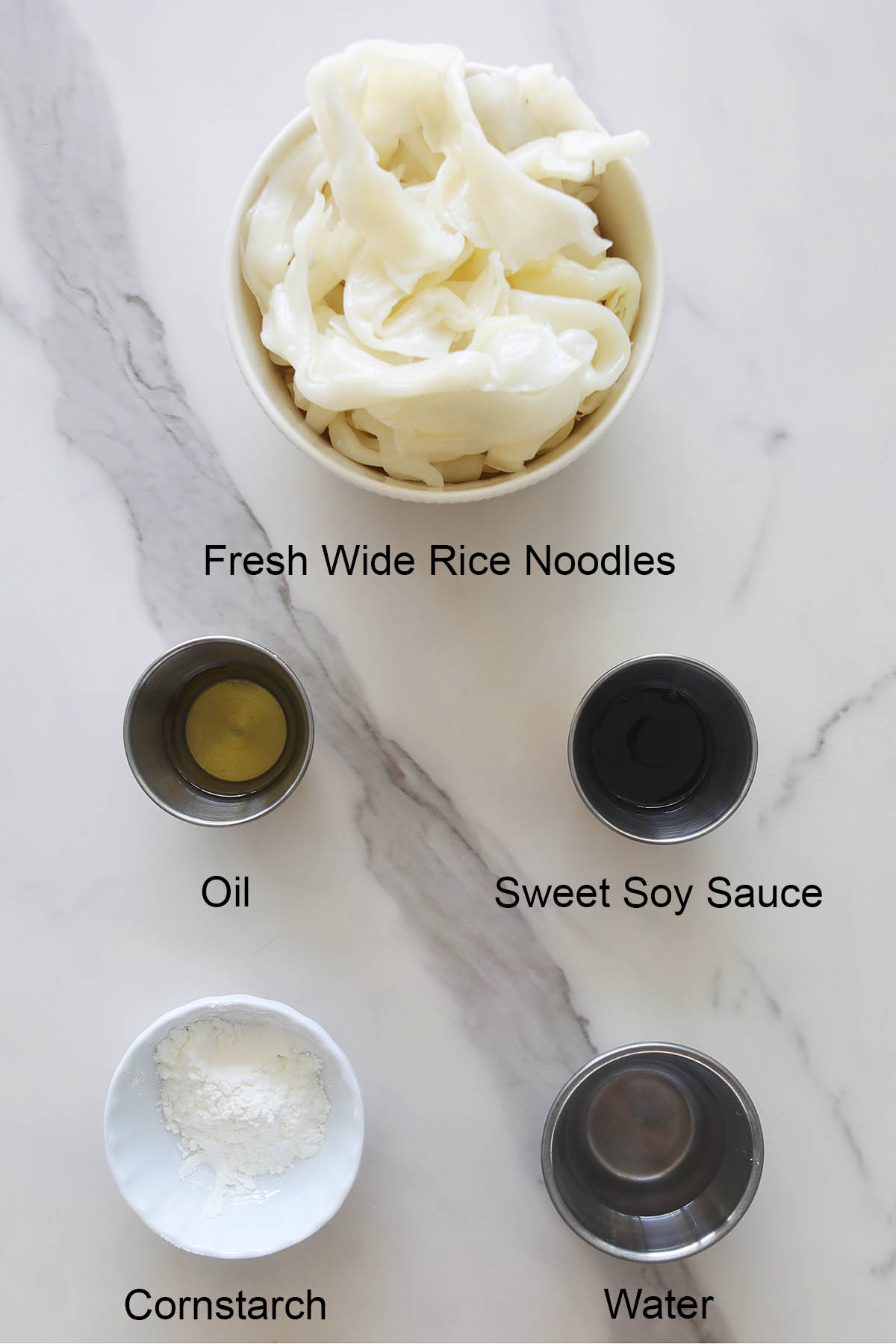
The main ingredients consist of the following:
- Flat wide rice noodles – wide kuay tiew.
- Oil
- Sweet soy sauce: This sauce imparts color and a mild sweetness to the kuay tiaw. Be sure to stir-fry the rice noodles in a wok over high heat until they clump together and develop a slightly toasty and smoky flavor, known in Chinese cuisine as wok hei.
Shopping Guide: In the United States, fresh rice noodles can be purchased at Whole Foods; look for the Nona Lim brand’s fresh Pad See Ew noodles (kuay tiew) for this recipe. If fresh noodles are unavailable, you can find dry rice stick noodles at Chinese and Asian food stores or online.
Rad Na Sauce (Gravy) Ingredients
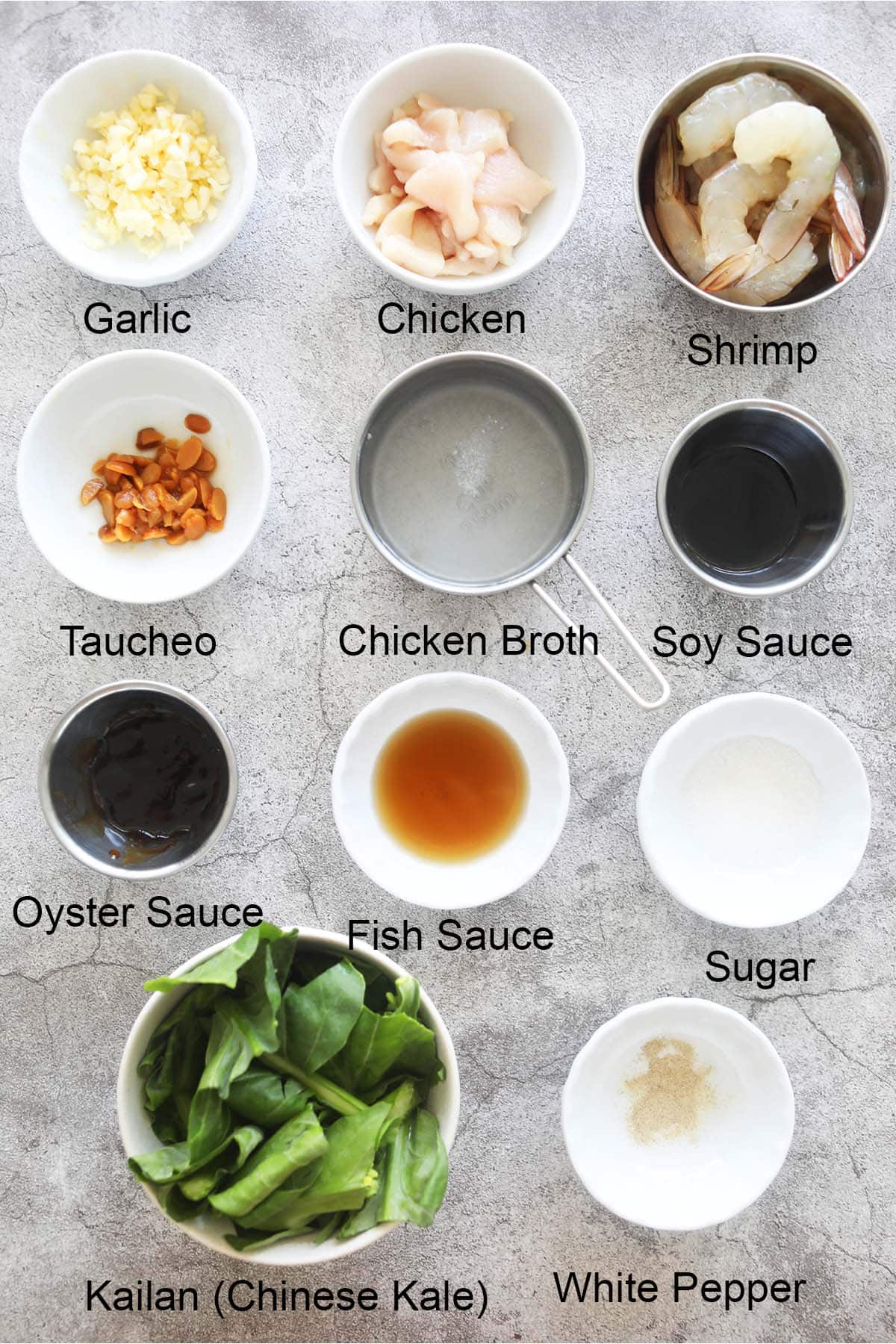
The mouthwatering, savory, slightly gooey sauce is made from the following ingredients:
- Garlic
- Chicken and shrimp
- Taucheo
- Chinese kale or gailan (kailan)
- Chicken broth
- Seasonings: soy sauce, oyster sauce, fish sauce
- Sugar
- Cornstarch slurry – it’s used to thicken the sauce.
How To Make Rad Na
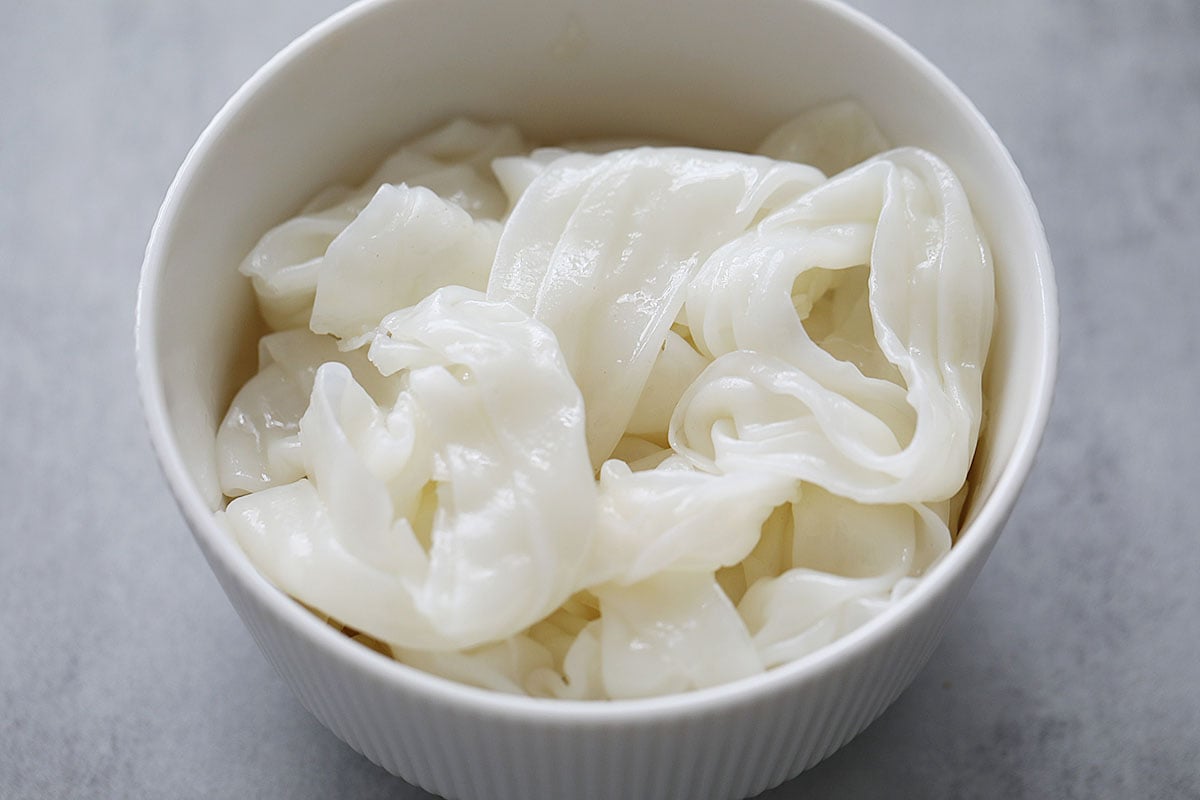
Step 1: Loosen the flat rice noodles with your hands and set them aside.
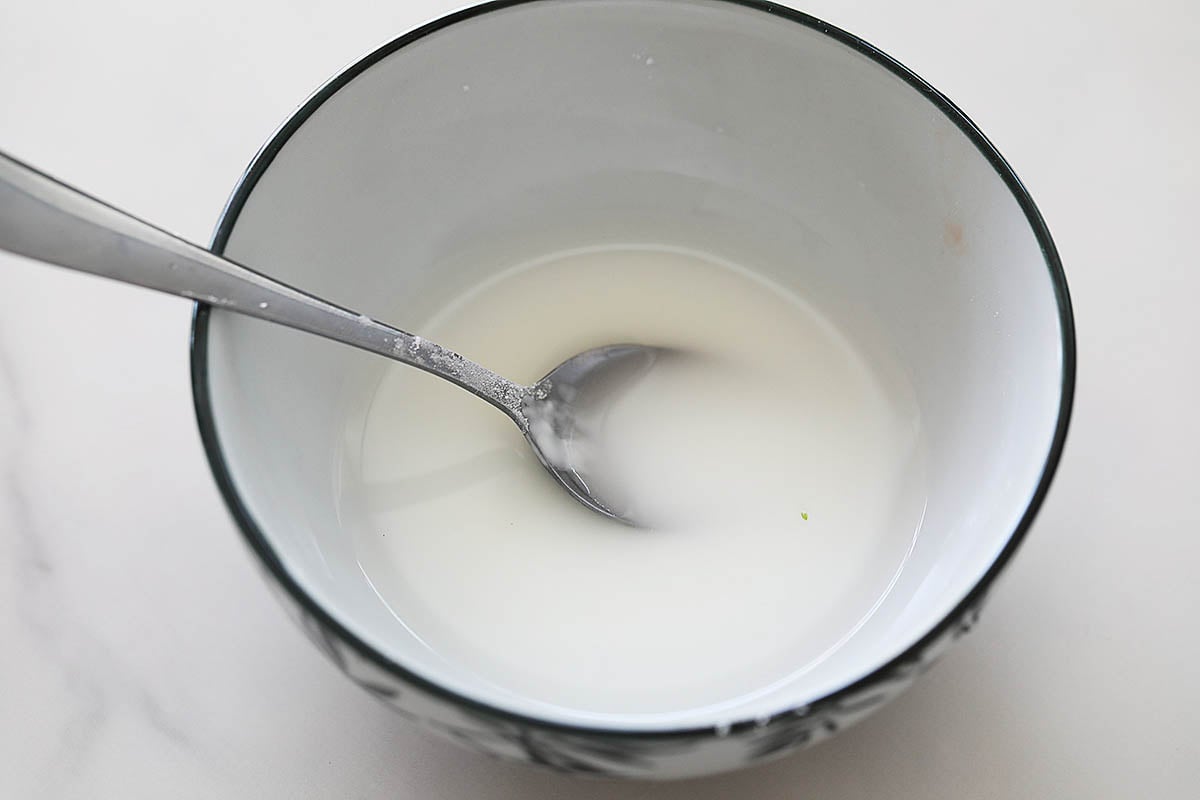
Step 2: Prepare the Cornstarch Slurry by mixing cornstarch with water. Stir until well combined and set aside.
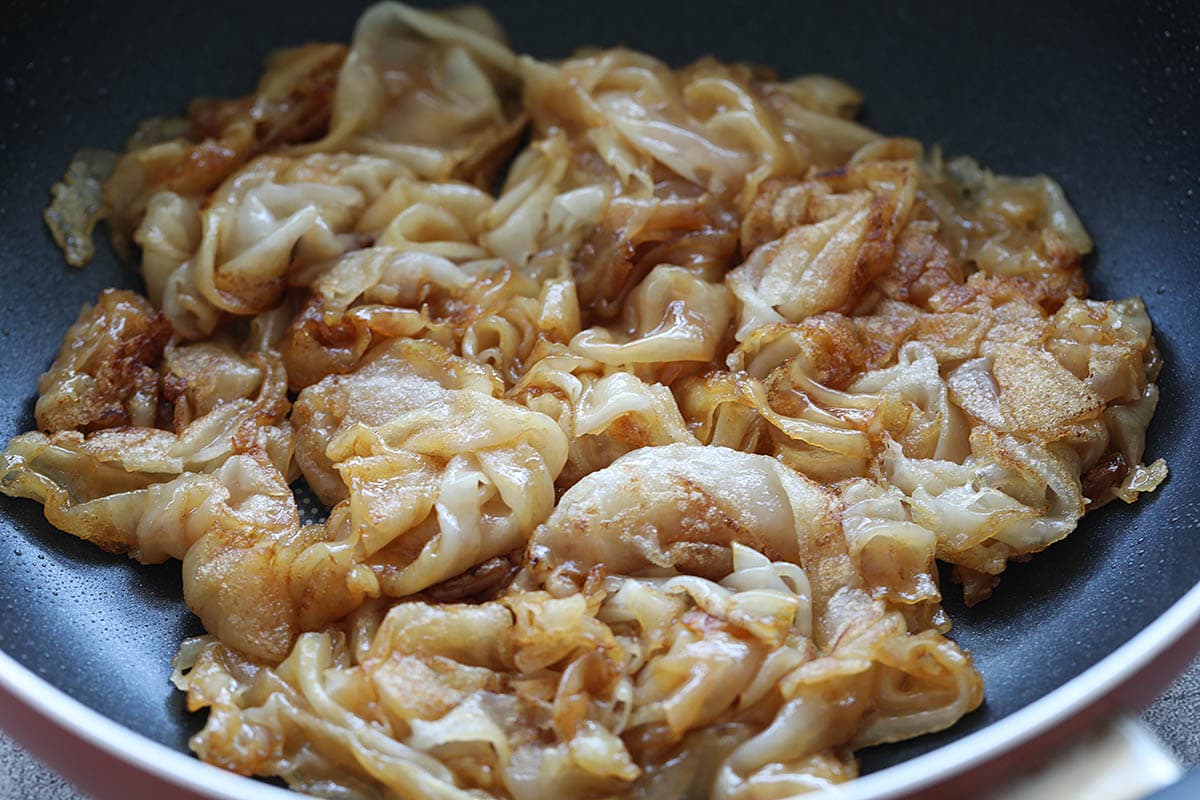
Step 3: Heat a wok with 1 tablespoon of oil. Once the oil is hot, add the rice noodles and give them a few quick stirs before adding the sweet soy sauce. Use a spatula to stir the noodles vigorously, ensuring the sauce is evenly distributed. Stir-fry for about 3-5 minutes, or until the noodles start to clump together and are slightly browned. Set them aside.
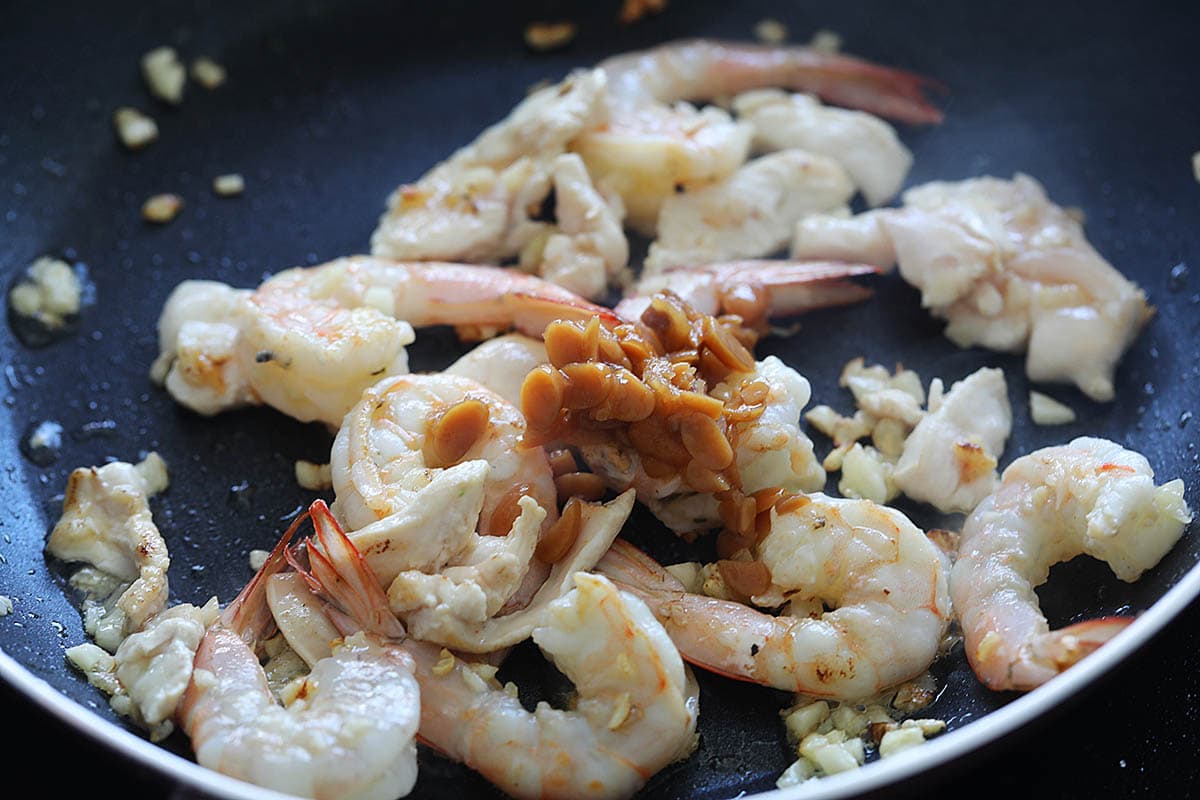
Step 4: Add the remaining 1 tablespoon of oil to the wok and heat it up. Sauté the garlic until it is light brown and aromatic, then add the chicken and shrimp. Stir-fry the ingredients until they turn white on the surface, then add the taucheo (preserved soy beans).
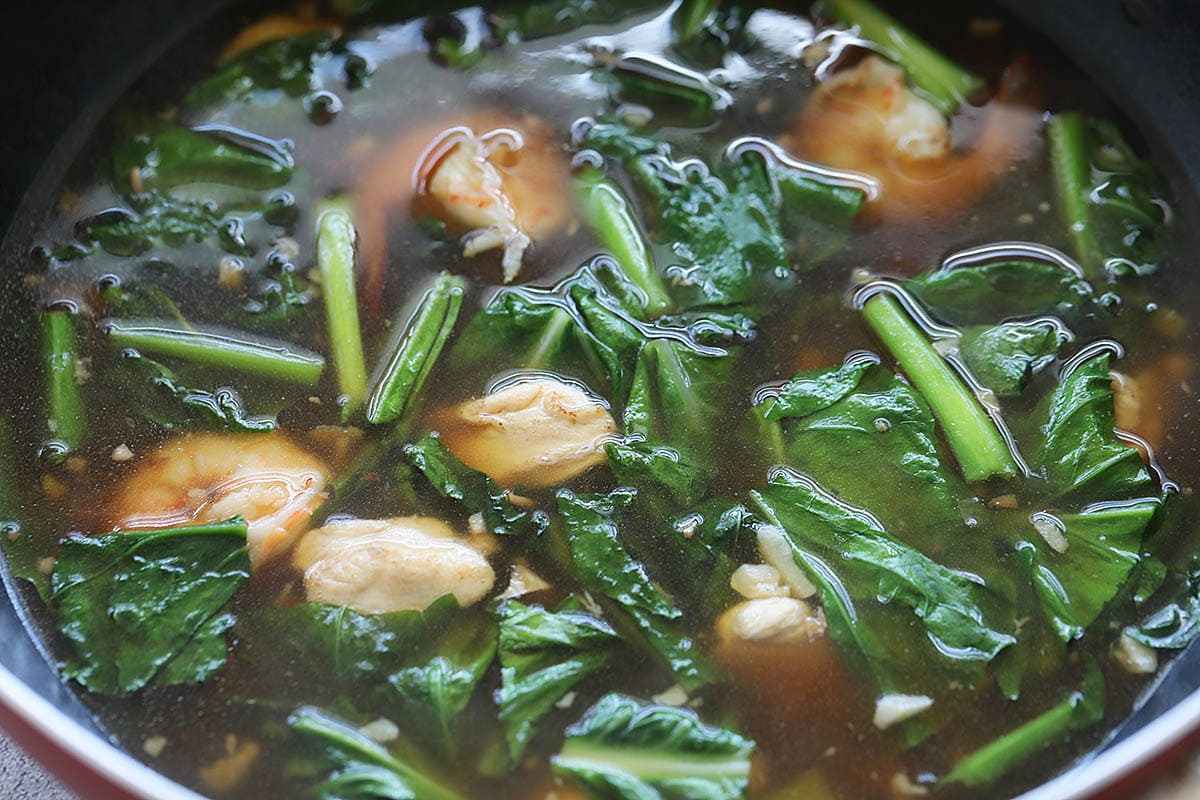
Step 5: Stir a few more times before adding the chicken broth, soy sauce, oyster sauce, fish sauce, sugar, and kailan. Bring the sauce to a boil, then thicken it with the cornstarch slurry. Once the sauce is thick and gooey, turn off the heat.
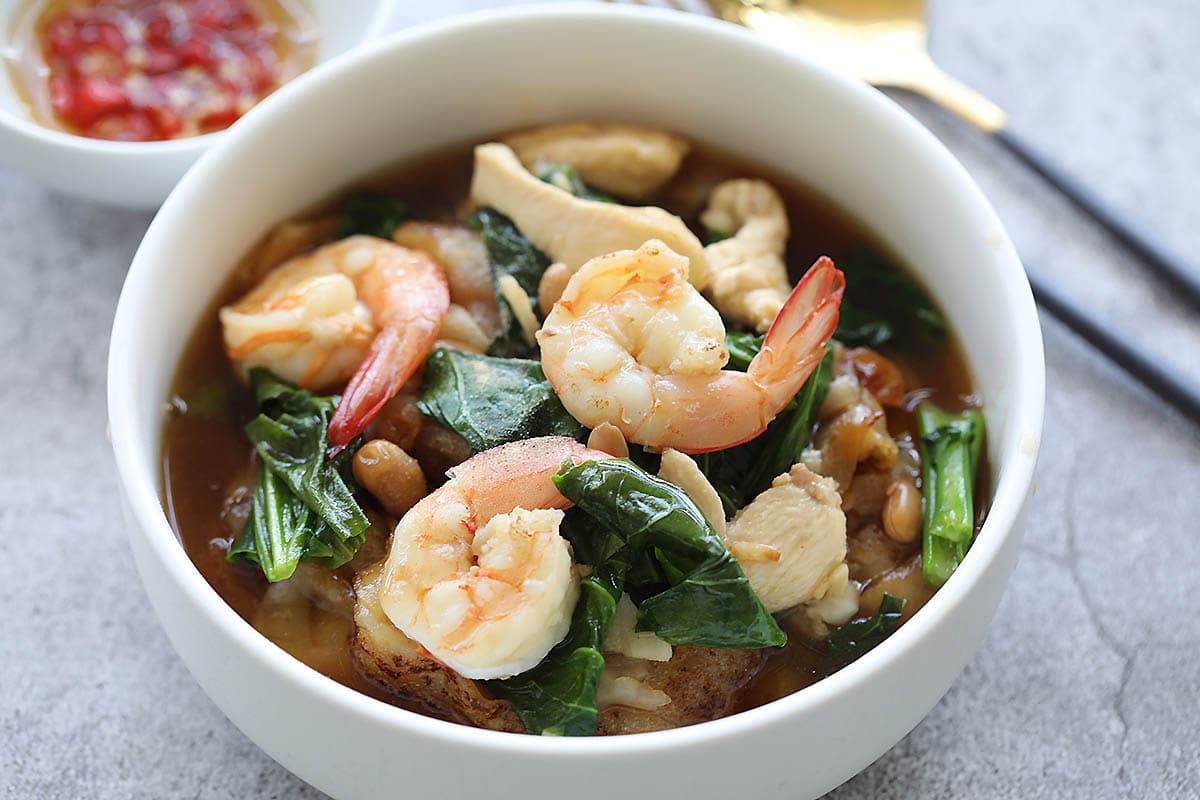
Step 6: On a serving plate, place a portion of the fried rice noodles and pour the sauce over the top. Add an even distribution of chicken, shrimp, and vegetables. Sprinkle a dash of ground white pepper over the Rad Na noodles before serving. Rad Na is excellent with a side of pickled green chilies or sliced Thai chilies.
Helpul Tips For Home Cooks
- Use Fresh Ingredients: Opt for fresh flat rice noodles, vegetables, chicken and shrimp. Even though you can make this dish with dried rice noodles, fresh noodles make it so much more vibrant and delicious, just like how it’s made in Thailand.
- Prep in Advance: Prepare and measure all your ingredients before you start cooking. This ensures you have everything you need and helps prevent last-minute scrambling.
- Taste as You Go: When making the sauce, continuously taste the gravy as it cooks to adjust seasoning and flavors. This helps you achieve the perfect balance and avoid over-seasoning.
Frequently Asked Questions
While traditional and authentic Rad Nah uses flat rice noodles, you can substitute with other types of noodles such as rice vermicelli, egg noodles or even udon. Adjust cooking times as needed based on the noodle type.
It is optional. You can skip it if it is unavailable.
This recipe is 964 calories per serving.
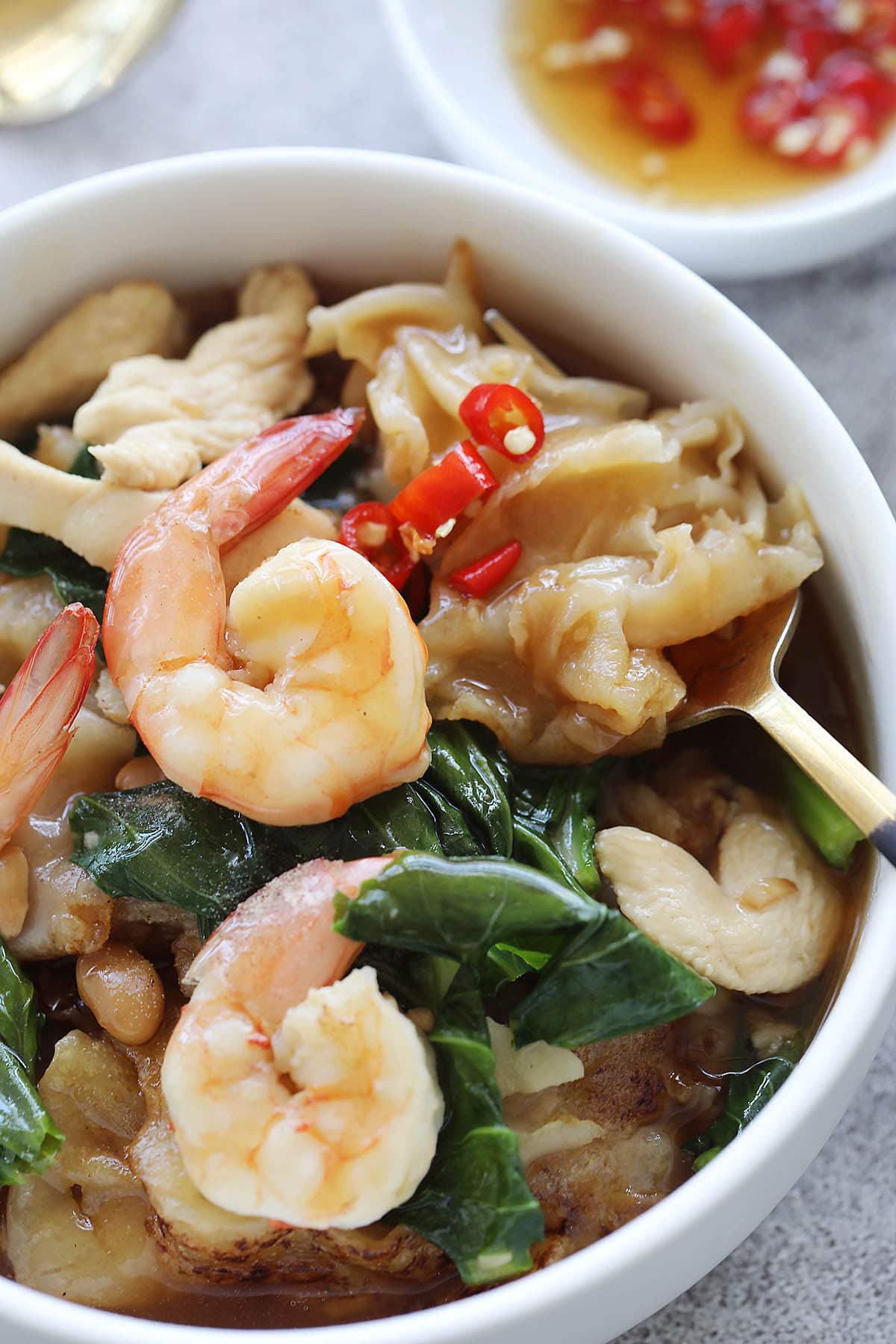
What To Serve With Rad Nah Noodles
For a wholesome Thai meal and dinner at home, I recommend the following recipes.
I hope you enjoy this post as much as I do. If you try my recipe, please leave a comment and consider giving it a 5-star rating. For more easy and delicious recipes, explore my Recipe Index, and stay updated by subscribing to my newsletter and following me on Facebook, Pinterest, and Instagram for new updates.
Other Recipes You Might Like
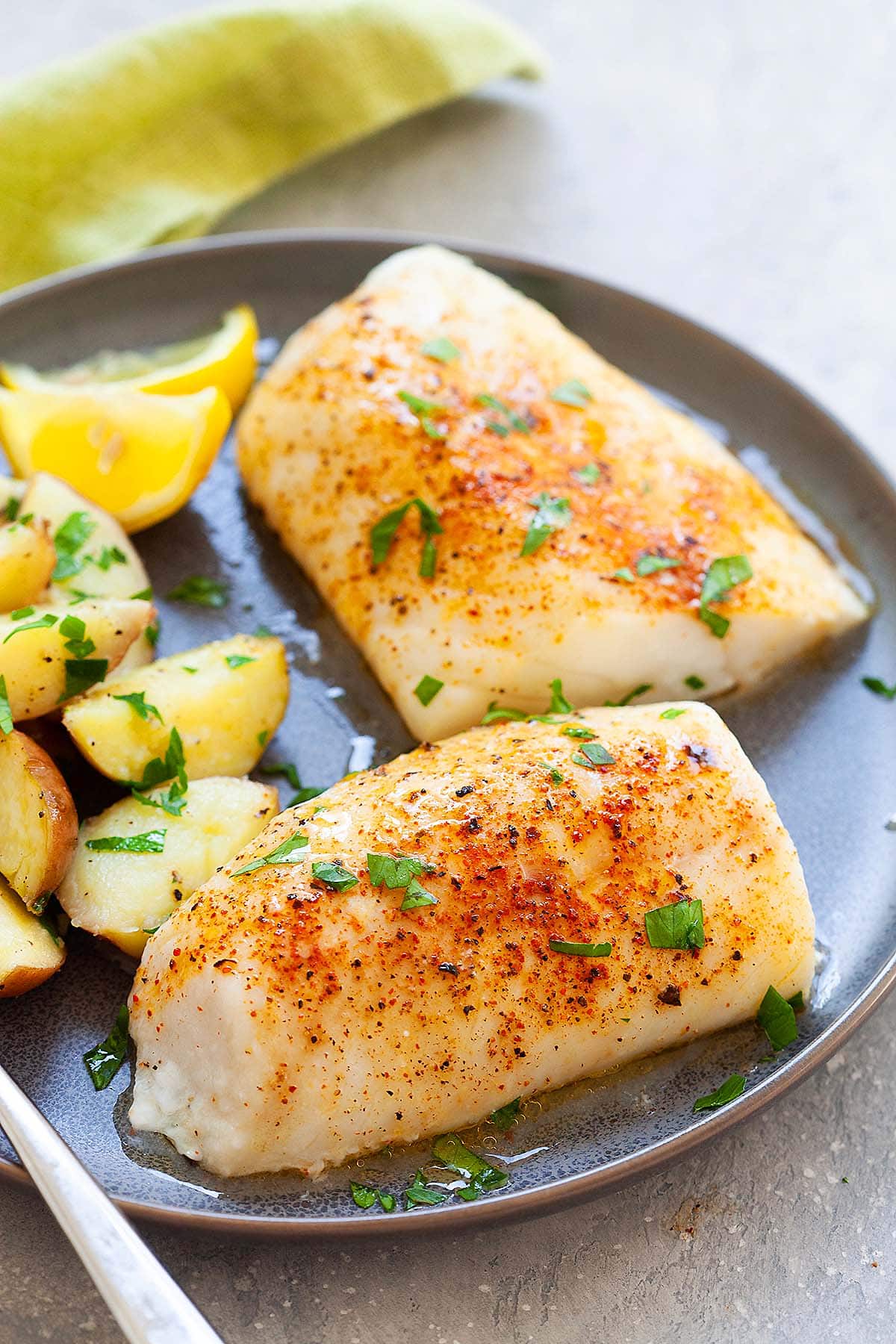
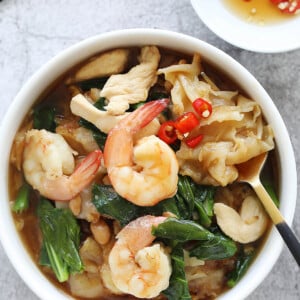
Rad Na
Ingredients
- 1 1/2 lbs (700g) fresh wide rice noodles, loosened
- 2 tablespoons oil
- 1 tablespoon sweet soy sauce, Kecap Manis
Cornstarch Slurry:
- 1 tablespoon cornstarch
- 3 tablespoons water
Other Ingredients:
- 4 cloves garlic, minced
- 2 oz (60g) chicken, cut into thin slices
- 6 to 8 medium-sized shrimp, shelled and deveined, but leave tail intact
- 1/2 tablespoon taucheo, preserved soy beans
- 1 1/2 – 2 cups low-sodium chicken broth
- 1 tablespoon soy sauce
- 1 tablespoon oyster sauce
- 1 tablespoon fish sauce
- 1/2 teaspoon sugar or to taste
- 2 oz (60g) Chinese gailan or kailan, cut into 2-inch/5-cm lengths
- 2 dashes ground white pepper, for serving
Instructions
- Loosen the flat rice noodles with your hands and set them aside.
- Prepare the Cornstarch Slurry by mixing cornstarch with water. Stir until well combined and set aside.
- Heat a wok with 1 tablespoon of oil. Once the oil is hot, add the rice noodles and give them a few quick stirs before adding the sweet soy sauce. Use a spatula to stir the noodles vigorously, ensuring the sauce is evenly distributed. Stir-fry for about 3-5 minutes, or until the noodles start to clump together and are slightly browned. Set them aside.
- Add the remaining 1 tablespoon of oil to the wok and heat it up. Sauté the garlic until it is light brown and aromatic, then add the chicken and shrimp. Stir-fry the ingredients until they turn white on the surface, then add the taucheo (preserved soy beans).
- Stir a few more times before adding the chicken broth, soy sauce, oyster sauce, fish sauce, sugar, and kailan. Bring the sauce to a boil, then thicken it with the cornstarch slurry. Once the sauce is thick and gooey, turn off the heat.
- On a serving plate, place a portion of the fried rice noodles and pour the sauce over the top. Add an even distribution of chicken, shrimp, and vegetables. Sprinkle a dash of ground white pepper over the Rad Na noodles before serving. Rad Na is excellent with a side of pickled green chilies or sliced Thai chilies.
Video
Notes
- The flat rice noodles used in Rad Na are wider than standard noodles. I usually buy fresh rice noodle sheets and cut them into about 1 1/2-inch wide strips, peeling them off sheet by sheet before cooking. Alternatively, you can purchase pre-cut flat rice noodles.
- Use Fresh Ingredients: Opt for fresh flat rice noodles, vegetables, chicken and shrimp. Even though you can make this dish with dried rice noodles, fresh noodles make it so much more vibrant and delicious, just like how it’s made in Thailand.
- Taste as You Go: When making the sauce, continuously taste the gravy as it cooks to adjust seasoning and flavors. This helps you achieve the perfect balance and avoid over-seasoning.
- Prep in Advance: Prepare and measure all your ingredients before you start cooking. This ensures you have everything you need and helps prevent last-minute scrambling.
Nutrition
Nutrition information is automatically calculated, so should only be used as an approximation.
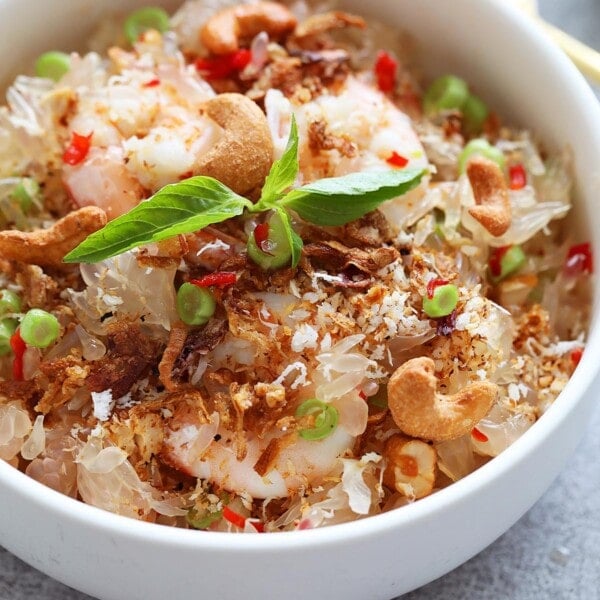

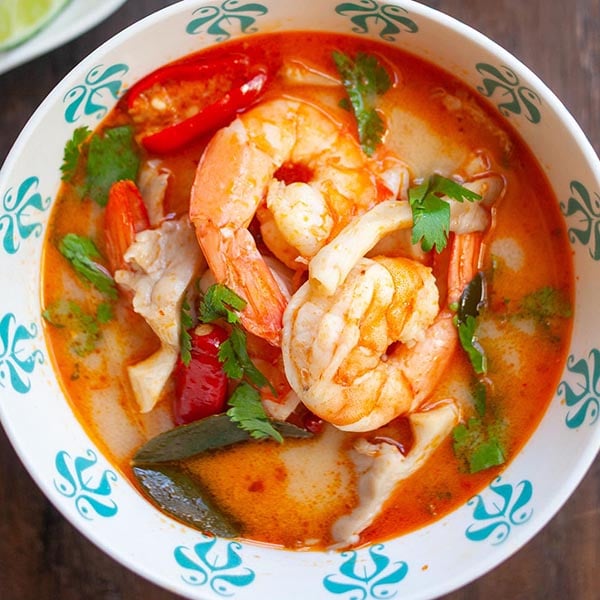
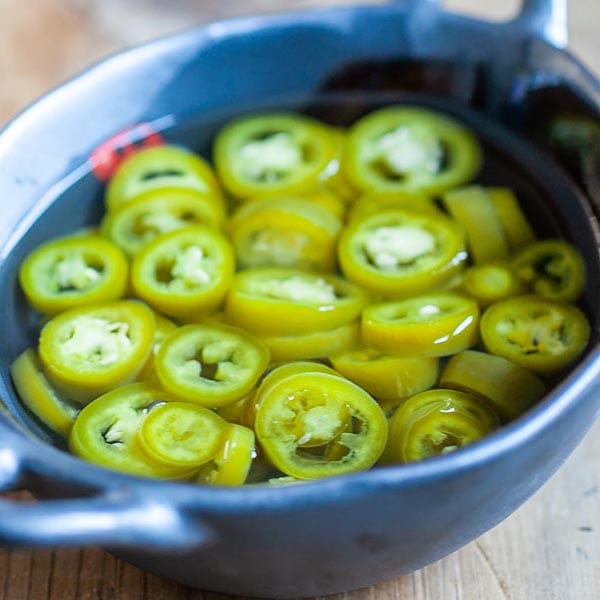






Can I use the Korean bean paste as a substitute for taucheo?
Yes you can.
Im drooling looking at these pics. Is there a substitute for the bean paste? I have all the other ingredients right now but that.
You can skip just add a little salt to taste.
Can I use ground bean paste sauce or salted bean sauce instead?
Yes, ground is fine.